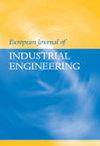基于元启发式算法的低成本机器人装配线优化
IF 1.9
4区 工程技术
Q3 ENGINEERING, INDUSTRIAL
引用次数: 2
摘要
利用机器人装配线(RAL)是因为它为整个生产系统提供了灵活性。各行业主要关注降低运营成本。从文献调查中可以看出,在RAL的成本相关优化领域,只有很少的研究报告。本文重点提出了一种RAL的新模型,其主要目标是通过最小化装配线总成本来最大化生产线效率。所提出的模型可用于生产经理以有效的方式平衡RAL。由于简单的装配线平衡问题属于NP难问题,由于附加约束而提出的问题也属于同一类。应用粒子群优化(PSO)和微分进化(DE)作为优化工具来解决这一问题。在一组已报道的基准问题上测试了该算法的性能。通过比较研究,发现所提出的DE算法对大多数测试问题都获得了更好的解。【接收日期:2018年7月2日;修订日期:2018月16日;修订时间:2019年5月8日;接受日期:2019年8月2日】本文章由计算机程序翻译,如有差异,请以英文原文为准。
Optimisation of cost efficient robotic assembly line using metaheuristic algorithms
Robotic assembly lines (RALs) are utilised due to the flexibility it provides to the overall production system. Industries mainly focus on reducing the operation costs involved. From the literature survey it can be seen that only few research has been reported in the area of cost related optimisation in RALs. This paper focuses on proposing a new model in RALs with the main objective of maximising line efficiency by minimising total assembly line cost. The proposed model can be used production managers to balance a RAL in an efficient manner. Since simple assembly line balancing problem is classified as NP-hard, proposed problem due to additional constraints also falls under the same category. Particle swarm optimisation (PSO) and differential evolution (DE) are applied as the optimisation tool to solve this problem. The performances of this proposed algorithm are tested on a set of reported benchmark problems. From the comparative study, it is found that the proposed DE algorithm obtain better solutions for the majority of the problems tested. [Received: 2 July 2018; Revised: 16 December 2018; Revised: 8 May 2019; Accepted: 2 August 2019]
求助全文
通过发布文献求助,成功后即可免费获取论文全文。
去求助
来源期刊

European Journal of Industrial Engineering
工程技术-工程:工业
CiteScore
2.60
自引率
20.00%
发文量
55
审稿时长
6 months
期刊介绍:
EJIE is an international journal aimed at disseminating the latest developments in all areas of industrial engineering, including information and service industries, ergonomics and safety, quality management as well as business and strategy, and at bridging the gap between theory and practice.
 求助内容:
求助内容: 应助结果提醒方式:
应助结果提醒方式:


